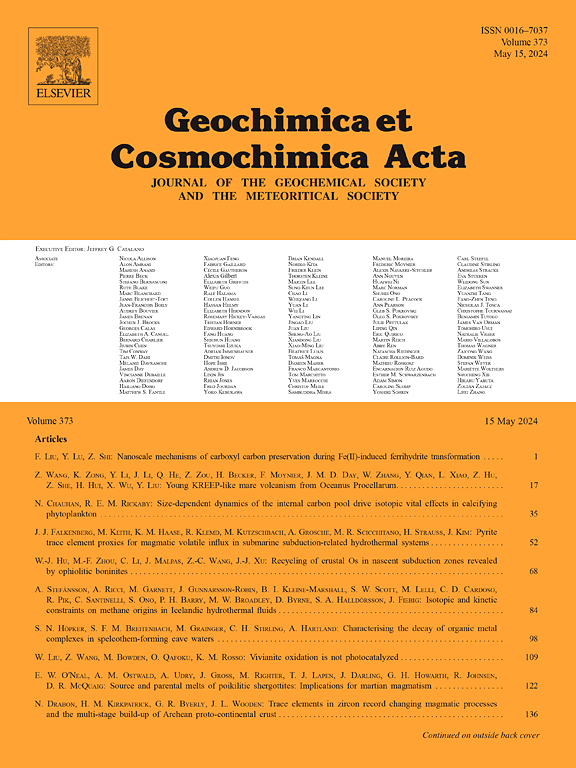Soda lake phosphorus fluxes controlled by biological uptake imply abundant phosphate in plausible origin-of-life environments
IF 4.5
1区 地球科学
Q1 GEOCHEMISTRY & GEOPHYSICS
引用次数: 0
Abstract
Phosphate is crucial for the origin of life but typical environmental concentrations are too low for prebiotic synthesis of essential biomolecules like nucleic acids. However, evaporative, sodium-carbonate rich “soda” lakes can accumulate extreme phosphate levels sufficient for prebiotic synthesis. In modern soda lakes, this presumably requires small biological and inorganic (apatite mineral formation) sinks, but the relative importance of these sinks is unclear because studies on phosphorus fluxes in soda lakes are lacking. Here, we quantified phosphorus source and sink fluxes in the extremely phosphate-rich Last Chance Lake (LCL), Canada, and neighboring, moderately phosphate-rich, Goodenough Lake (GL). Within the total phosphorus (0.1 wt%) in LCL sediments, sequential extraction showed 61 % detrital apatite, ∼19 % dissolved phosphate, ∼11 % organic-bound phosphorus (Porg), 6 % carbonate-bound P, and ∼2 % authigenic apatite. Combining these measurements with hydrological fluxes, we demonstrate that evapo-concentration of dilute inflow sufficed to accumulate tens of millimolar phosphate on a millennial timescale due to small sinks. Low apatite formation rates directly confirmed a previously hypothesized mechanism allowing extreme phosphate solubility at high carbonate concentrations. Yet, it is its 18 × lower Porg formation rates that mainly distinguish LCL from the less phosphate-rich, more biologically active GL. Because low productivity is key, evaporative soda lakes on prebiotic Earth should have commonly attained millimolar phosphate levels. Consequently, we identify soda lakes as the only known natural environments with sufficiently high phosphate levels for critical phosphorylation and catalysis in prebiotic synthesis.
求助全文
约1分钟内获得全文
求助全文
来源期刊

Geochimica et Cosmochimica Acta
地学-地球化学与地球物理
CiteScore
9.60
自引率
14.00%
发文量
437
审稿时长
6 months
期刊介绍:
Geochimica et Cosmochimica Acta publishes research papers in a wide range of subjects in terrestrial geochemistry, meteoritics, and planetary geochemistry. The scope of the journal includes:
1). Physical chemistry of gases, aqueous solutions, glasses, and crystalline solids
2). Igneous and metamorphic petrology
3). Chemical processes in the atmosphere, hydrosphere, biosphere, and lithosphere of the Earth
4). Organic geochemistry
5). Isotope geochemistry
6). Meteoritics and meteorite impacts
7). Lunar science; and
8). Planetary geochemistry.
 求助内容:
求助内容: 应助结果提醒方式:
应助结果提醒方式:


